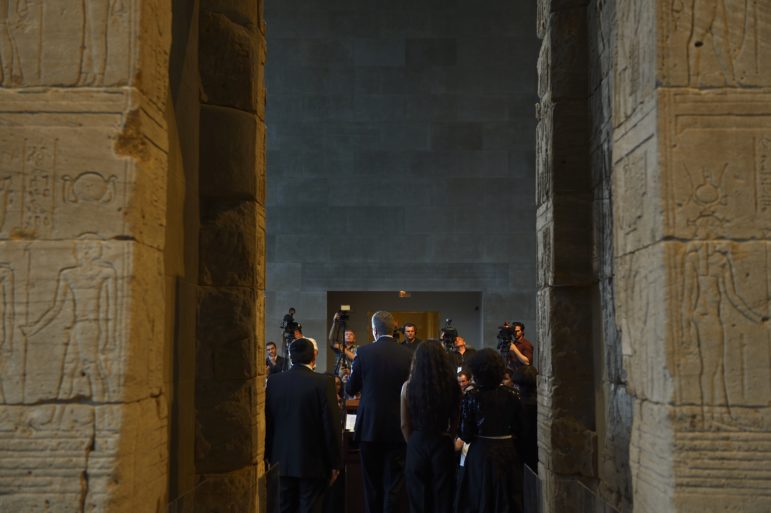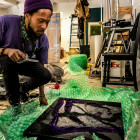
Rob Bennett for the Office of Mayor Bill de Blasio
Mayor de Blasio at a 2014 reception in Reception at the Metropolitan Museum of Art’s Temple of Dendur.
“Can anyone get me tickets to Hamilton?” It’s the question of the day, but there’s an equally relevant question buried in the Hamilton phenomena: namely, where did it begin? If you answered The Public Theater, you may already appreciate the fantastic role that government support for the arts plays in nurturing exciting and thought-provoking culture in our city.
From world-renowned museums and performance venues to botanical gardens, pop-up art installations and dance festivals, arts and culture are an essential element in our city’s social fabric. The arts and creative sector are spread across the five boroughs and are as diverse as the city’s residents and the millions of tourists who visit each year. An integral part of civic life, the arts greatly improve social well-being and community vitality. They also generate tremendous economic activity while inspiring New Yorkers and visitors alike.
As the mayor and City Council focus on creating a budget that provides essential services for all city residents, increasing support in the city’s budget for arts and culture should be a top priority. Investing in the many great organizations and artists that are at the intersection of the city’s economic and cultural life is an investment in the social fabric itself.
That is why we are joining with arts groups, large and small, and thousands of New Yorkers from across the city in a grassroots effort called #NYCInspires, calling on the city to increase the budget of the Department of Cultural Affairs by $40 million.
The economic benefits that the arts and creative sector bring to New York City are indisputable. Our arts and cultural venues attract millions of visitors, provide jobs across the five boroughs, and increase the city’s tax base. What begins with a museum visit to an East Harlem institution like El Museo continues with lunch at a neighborhood restaurant or coffee and pastry at another local haunt, and so on. All this feeds the local micro-economies that contribute to community development and the vibrancy of our neighborhoods.
Setting dollars aside, that museum visit may inspire a six-year old to go on to become an artist who may one day see his or her art hung in that same institution, or to develop a love and appreciation for art and history that will nurture and nourish that child’s education, career and personal aspirations for a lifetime.
* * *
Art at the Limits
Where art and politics collide
* * *
In fact, our city’s public-school students have long learned about history, science and culture through field trips to our many museums and performance spaces. Hundreds of thousands of city students are inspired and awestruck standing beneath the giant blue whale at the Museum of Natural History each and every year. That experience is a rite of passage for many and one that we should work together to make available to all.
Our organizations are two of almost 400 arts and cultural entities that partner directly with city public schools to enrich and reinforce the school-day curriculum with music, dance, theater and visual arts.
For example, each year The Center for Arts Education brings arts and creative learning opportunities to more than 10,000 New York City public-school students. These programs expand students’ artistic skills while also preparing them to succeed in the 21st century workforce—not necessarily as artists or performers, but as marketing professionals, program administrators and entrepreneurs. El Museo del Barrio, in addition to being the nation’s first Latino and Latin American arts museum, provides innovative bilingual education and public programs to the same student population, as well as to youth and seniors with autism, dementia and Alzheimer’s disease.
Yet, despite the reach of our collective work, we know there is still a long way to go until every child has access to this rich and engaging education. Close to 250 city schools have no arts or cultural partnerships. That’s roughly the size of the entire Philadelphia school district. Increased investment in the city’s budget for arts and culture will help close this gap and give all students the educational opportunities they deserve.
New York City’s arts and cultural experiences also bring families and communities together, providing lifelong memories and enjoyment to New Yorkers of all ages and from all economic and social backgrounds. What’s more, the creative sector supports local artists and arts groups in bringing inspiration and enjoyment to the elderly at senior centers across the five boroughs and therapeutic healing to countless New Yorkers in need. This inspiration and engagement is also part of the social fabric of our great city—it is what binds and keeps us together.
For all of these important reasons, we have joined together to call for a $40 million increase in the city’s investment in arts and culture. Increasing the city’s commitment in this arena will help expand access to arts and cultural opportunities for all New Yorkers and ensure the necessary public support that helped Hamilton and its fresh storytelling reach the heights.
***
Jorge Daniel Veneciano is the Executive Director at El Museo del Barrio and Lisa Robb is the Executive Director at The Center for Arts Education.









